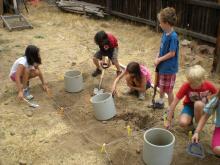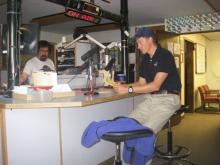What Are They Doing?
Fluted projectile points are small stone tools created from rock that were used by early humans as knives, arrowheads, or both. Finding, interpreting, and dating fluted projectile points can help archaeologists learn more about the earliest humans to inhabit the Americas.
On this project, the team looked for fluted projectile points at the Raven Bluff Site in northwest Alaska to learn more about the early inhabitants of Alaska and the arctic. Fossil plants also at the site helped the researchers determine the age of these artifacts, which were estimated to be from the late Pleistocene age or about 10,000 years old.
This research helped lead to important discoveries about the timing and settlement of humans in the New World. In addition, it helped build knowledge about how people used these tools, hunted, and survived during this period of time.
Where Are They?
The field team met in Fairbanks, Alaska and flew by chartered aircraft to a private airport at the Red Dog Mine. From the Red Dog Mine, the team and their equipment and supplies were shuttled about 50 km by helicopter where a field camp was set up near the Raven Bluff archaeological site in northwestern Alaska.
Latest Journals

Dr. Jeff Rasic specializes in prehistoric stone tool technology and the archaeology of northern hunter-gatherers. He is particularly interested in how the earliest people of the North made a living at the end of the last ice age. He is currently the acting curator of Archaeology at the University of Alaska Museum of the North, and an archaeologist at the National Park Service in Fairbanks. He has worked in the Caribbean, and throughout the United States, and since 1995 has focused on field work and research projects in Alaska, especially the northern and interior portions of the state.

Bill Hedman is the archaeologist for the federal Bureau of Land Management (BLM) Cental Yukon Field Office based in Fairbanks, Alaska. Bill has been working in archaeology for about 20 years, over 15 of which have been spent conducting fieldwork in Alaska. This work has taken him from the tip of the southeast panhandle to the Aleutian Islands to the North Slope of Alaska and many points in between. Being involved in everything from federal permitting for mineral exploration along the Dalton Highway to helicopter surveys in the DeLong Mountains is typical for Bill's field seasons. His favorite part of the job is figuring out how to get several thousand pounds of gear, people, fuel, and aircraft to some of the most remote corners of Alaska to find and test archaeological sites.





